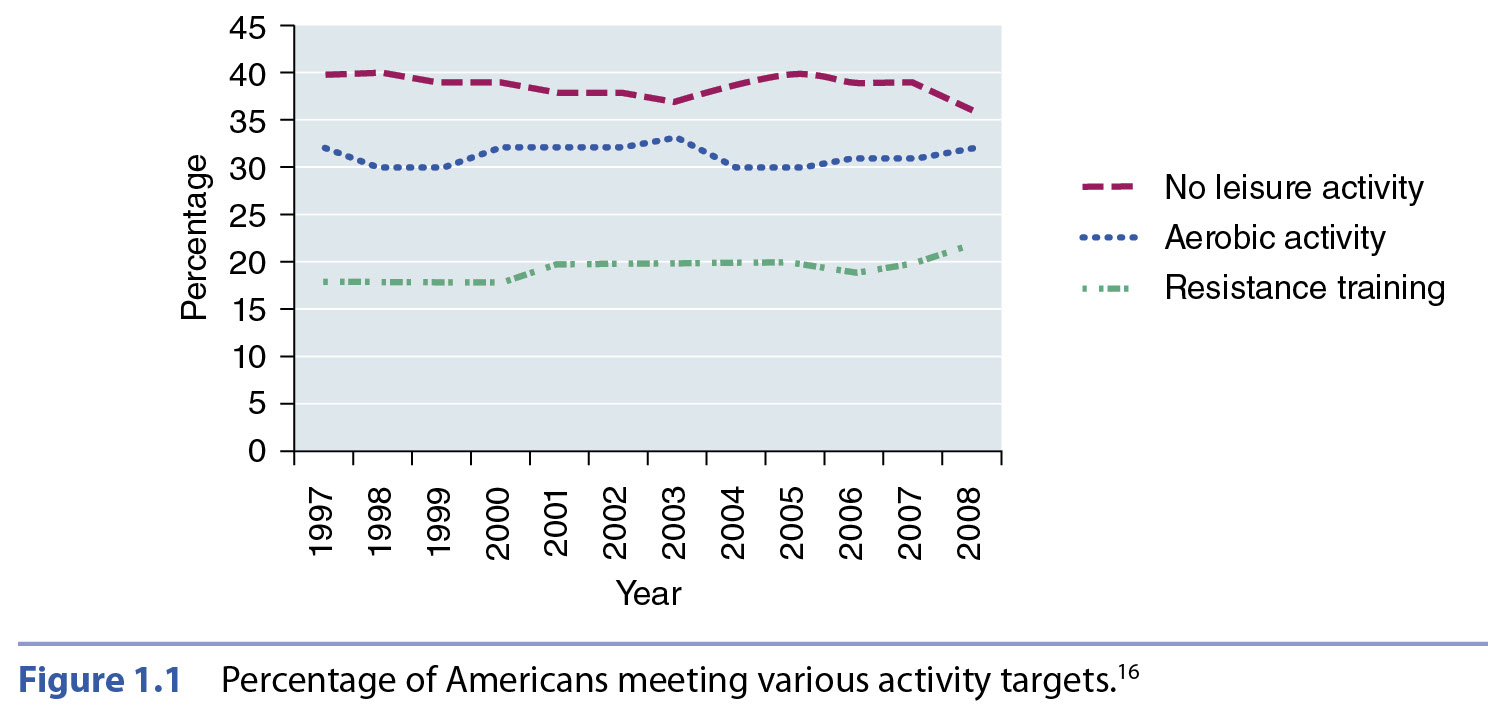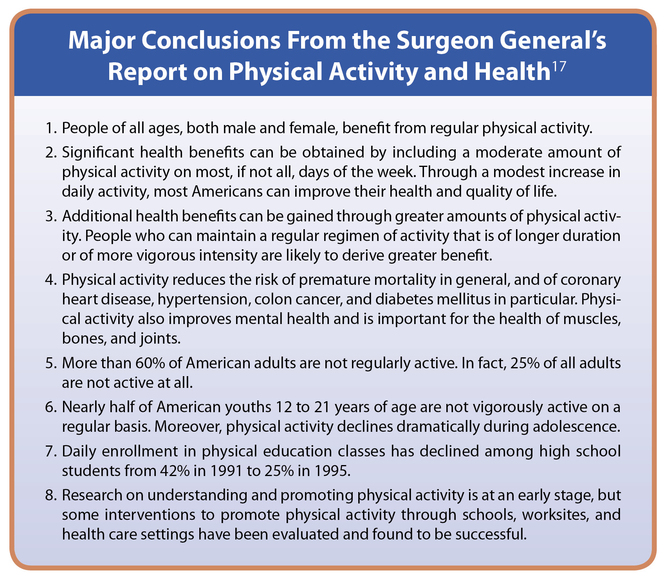Physical Activity Guidelines
Physical activity recommendations are not new, although the message has been clarified in recent years. In 1996, the U.S. Surgeon General’s Report on Physical Activity and Health17 was considered a landmark on par with the 1964 Surgeon General’s Report on Smoking and Health. At the time of its release, the Secretary of Health and Human Services, Donna Shalala, described it as "a passport to good health for all Americans."17 She went on to suggest that physical activity be woven into the fabric of daily life.17The main take-home messages of the Surgeon General’s report included the following17 (for the eight major conclusions, see Major Conclusions From the Surgeon General’s Report on Physical Activity and Health):
- Americans can substantially improve their health and quality of life by including moderate amounts of physical activity in their daily lives.
- For those who are already achieving regular moderate physical activity, additional benefits may be gained by further increases in activity levels.
- Health benefits from physical activity are achievable for most Americans.


Although the Surgeon General’s report gave high-level attention to the importance of physical activity, it did not ultimately spark the increase in physical activity desired and needed. See figure 1.1 for the trend lines for aerobic (endurance) and resistance training activities from 1997 to 2008.16 Over this 12-year time span, little has changed. In addition, notice the line showing the percentage of people who are inactive in their leisure time.16 Ideally, a steady decline would be noted in sedentary behavior, but unfortunately, there has been no significant decrease in inactivity.
Armed with increased awareness of the value of physical activity provided by the Surgeon General’s report, the U.S. Department of Health and Human Services provided clear recommendations on physical activity in its 2008 Physical Activity Guidelines for Americans.18 The Physical Activity Guidelines for Americans includes information on activity for people of all ages, including those with special needs. The upcoming chapters reflect these research-based guidelines, providing more detail on the components of a balanced exercise program and the role activity and nutrition play in promoting health and fitness throughout the lifespan as well as when faced with special health conditions.
The benefits of physical activity are very real for everyone throughout the lifespan. For adults, check out your age category in figure 1.2. The most active age group is the youngest; unfortunately, activity decreases and inactivity increases with age.

In a perfect scenario, 100% of people would exercise (aerobically and with resistance training) and be active in their leisure time. Currently, the percentages are far from that ideal. It is time for everyone to increase physical activity and find enjoyable ways to be more active.
Children and Adolescents
Regularly active youth (ages 6 to 17) appear to have a better chance of growing into healthy adults.18 Chronic diseases such as heart disease, high blood pressure, type 2 diabetes, and osteoporosis can have their roots early in life.18 Regular physical activity can lower the risk of developing these diseases. Physical activity is also a tool to help prevent obesity. Although research supports the benefits of physical activity, unfortunately, activity levels typically decrease throughout adolescence.1 To combat this activity reduction, adults should provide opportunities for physical activity, thus paving the way for lifelong physical activity habits.18
Children and adolescents are not small adults, and thus, the recommendations for physical activity are slightly different. Children should accumulate at least an hour, and up to several hours, of age-appropriate physical activity on a daily basis. Aerobic activities such as bicycle riding, skateboarding, jumping rope, and playing soccer (or other team sports) are recommended.18 In addition, children should include muscle-strengthening activities such as push-ups, pull-ups, tug-of-war games, and swinging on playground equipment, as well as bone-strengthening activities such as hopscotch, skipping, jumping, gymnastics, and other sports (e.g., basketball, volleyball, tennis).18
Physical activity programs must be geared toward children’s and adolescents’ specific age and maturity levels.18 Including a variety of activities that youth find enjoyable is the key for continued activity into adulthood.
Adults
The benefits of a regular, balanced exercise program for adults (ages 18 to 64) are very clear. Physically active adults are typically healthier and have a lower chance of developing chronic diseases compared to their inactive peers.18 In addition, a physically active lifestyle along with good nutritional practices helps to keep body weight and body composition in a healthy range. As shown in figure 1.2, adulthood is typically a time of decreasing physical activity. To help combat this trend, chapter 10 highlights how adults can develop a plan to expand physical activity levels to include aerobic exercises as well as muscle-strengthening exercises on a regular basis. Just as adults focus on creating financial stability during these career-focused years via systematic savings and investments, so too should they consider regular exercise and proper nutrition to be investments in their health.
Older Adults
Older refers to adults 65 years of age or older.18 People in this age group tend to have more diversity with regard to health and fitness than younger adults. Older adults of the same chronological age may be very different in regard to health status.1 Whereas one 75-year-old may spend the day golfing and gardening, another may spend most of the day relatively inactive. Thus, the effects of aging are potentially compounded by deconditioning.1 In spite of the known health benefits of exercise, older adults are among the least active Americans. Close to half of Americans over 65 do not engage in any leisure time physical activity4 (see figure 1.2).
In addition to regular aerobic and muscle-strengthening activity, older adults should also incorporate exercises that maintain or improve balance. Unintentional falls affect approximately 30% of older adults each year.4 To help prevent falls, older adults should work on improving strength, balance, and flexibility as well as review medications, which could affect balance.
Women (Pregnancy and Postpartum)
Pregnancy is a time of major changes, including transformations within the body. Healthy women can continue to benefit from physical activity during pregnancy. Pregnant women who have an established regular vigorous physical activity regimen can continue a high level of activity during pregnancy and postpartum provided they remain healthy and work with their health care providers to adjust their activity levels if needed over time.
Read more about ACSM’s Complete Guide to Fitness & Health edited by Barbara A. Bushman, PhD, FASCM.